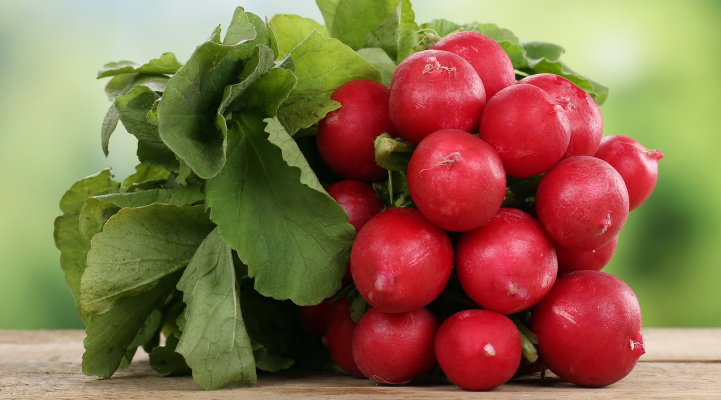Fresh, crisp and peppery – radishes are small, round bulbs that pack in flavour, and are among the first garden vegetables ready for harvest each year from April, providing us with a tasty ingredient that adds a little bit of spice to our recipes.
Use them raw in salads, as a topping on bread, or grated into a dip or cream cheese – versatile and delicious, radishes can be used to pep up a wide range of dishes. Even try them steamed – these little, pungent bombs make a fantastic accompaniment to hot food!
Radishes are healthy
With a high water content, radishes are very low in calories yet have a high nutrient content, being rich in vitamins and in minerals such as potassium, calcium, magnesium and iron. The mustard oil contained in the bulb gives them their sharp taste, and it also stimulates digestion and helps to support the immune system in its fight against viruses, bacteria and fungi. It can also help to combat gastrointestinal discomfort.
Small but mighty
Although radishes appear small and rather innocuous, at first sight, they actually pack quite a punch. But why do some radishes taste more peppery than others? The sharpness comes from mustard oils, and the more sunlight the radishes are exposed to, the hotter the mustard oils become. Radishes used to be regarded as a springtime vegetable only, but now they are grown right through until the late summer. Radishes harvested at the peak of summer may well be somewhat hotter than those picked in the spring, so we recommend adding some salt to alleviate the sharpness.
How to keep radishes fresher for longer
Radishes remain fresh in a refrigerator for up to 18 days. In a Liebherr BioFresh compartment, they can be stored for longer – up to 27 days. Radishes are not suitable for freezing as they lose their freshness, wilt, and are no longer crispy once defrosted.
A versatile ingredient
Radishes are perfect for adding to salads, and are a tasty, fresh ingredient in dips or in a spread for bread. If you are looking for a new and interesting way to enjoy the taste of radishes, you’ll find that the leaves are ideal for making pesto. Roughly chop up the leaves together with some coriander, and then stir in almonds, garlic, pepper, salt and olive oil to form a paste. If you like, you can add a little lemon juice too. This pesto tastes fabulous with pasta, is quick to make, and is a great way to stop radish leaves from being wasted.
Our tip: when buying radishes, check that the leaves are fresh and have no signs of wilting. Only the freshest leaves are suitable for making radish pesto. The radish leaves should be washed thoroughly and dried before use, as they are often very sandy.
What’s your favourite way to eat radishes? Please tell us about your culinary creations! Use the comment function below this post or start/join in discussions with us on Facebook, Twitter, Instagram or Pinterest.

